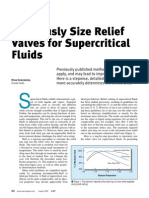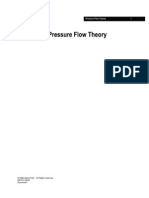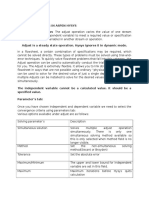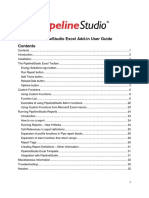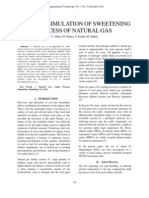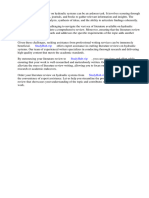0 ratings0% found this document useful (0 votes)
390 viewsRules of Dynamic Simulation
Rules of Dynamic Simulation
Uploaded by
Imtihan Komahatee1) There are 10 rules for effective dynamic simulation: every boundary stream should have one dynamic specification; never use flow specifications on streams; do not use dynamic specifications on internal streams; connect all boundary streams to resistance operations like valves; do not connect two pressure node operations without a resistance in between; controllers are essential; strip charts are needed to analyze trends over time; minimize use of duty streams for heat transfer; all columns must end with sumps; be careful using duty specifications on pumps.
Copyright:
© All Rights Reserved
Available Formats
Download as PDF, TXT or read online from Scribd
Rules of Dynamic Simulation
Rules of Dynamic Simulation
Uploaded by
Imtihan Komahatee0 ratings0% found this document useful (0 votes)
390 views1 page1) There are 10 rules for effective dynamic simulation: every boundary stream should have one dynamic specification; never use flow specifications on streams; do not use dynamic specifications on internal streams; connect all boundary streams to resistance operations like valves; do not connect two pressure node operations without a resistance in between; controllers are essential; strip charts are needed to analyze trends over time; minimize use of duty streams for heat transfer; all columns must end with sumps; be careful using duty specifications on pumps.
Original Description:
z
Copyright
© © All Rights Reserved
Available Formats
PDF, TXT or read online from Scribd
Share this document
Did you find this document useful?
Is this content inappropriate?
1) There are 10 rules for effective dynamic simulation: every boundary stream should have one dynamic specification; never use flow specifications on streams; do not use dynamic specifications on internal streams; connect all boundary streams to resistance operations like valves; do not connect two pressure node operations without a resistance in between; controllers are essential; strip charts are needed to analyze trends over time; minimize use of duty streams for heat transfer; all columns must end with sumps; be careful using duty specifications on pumps.
Copyright:
© All Rights Reserved
Available Formats
Download as PDF, TXT or read online from Scribd
Download as pdf or txt
0 ratings0% found this document useful (0 votes)
390 views1 pageRules of Dynamic Simulation
Rules of Dynamic Simulation
Uploaded by
Imtihan Komahatee1) There are 10 rules for effective dynamic simulation: every boundary stream should have one dynamic specification; never use flow specifications on streams; do not use dynamic specifications on internal streams; connect all boundary streams to resistance operations like valves; do not connect two pressure node operations without a resistance in between; controllers are essential; strip charts are needed to analyze trends over time; minimize use of duty streams for heat transfer; all columns must end with sumps; be careful using duty specifications on pumps.
Copyright:
© All Rights Reserved
Available Formats
Download as PDF, TXT or read online from Scribd
Download as pdf or txt
You are on page 1of 1
Before you push the dynamics button
10 Rules of Dynamic Simulation
Author: Mohamed Abouelhassan
Date: February 2004
Document Version: 1.0.0
Program Mode: Dynamics
Introduction:
Through my experience in using HYSYS Dynamics and
interacting with other users, I realized that there are many
ways to do the same thing, and it is a matter of preference as
to which way to go. One thing is common between the ways
though; you need to fully understand the implications of
your ways and how they affect your model.
This article presents 10 rules for dynamic simulation that I
follow at all times and never ignore. Some times, I choose to
deviate from a few of them for some purposes, but I always
keep them in mind.
I believe following these rules will keep you out of trouble
as you start your dynamic simulation experience, and will
eventually lead you to your own set of rules as you become
more experienced.
1.
Every boundary stream (feed or product stream)
should have one dynamic spec:
In real life there are no boundary streams. Every stream has
to come from or go to some where. The sources of these feed
streams or the destinations of product streams can be
approximated using specs on the boundary streams. For
example a pressure spec on a feed stream can approximate a
draw from a big pipeline, where the draw amount will not
affect the pressure inside the pipe. It can also approximate
suction of air directly from atmosphere, where the pressure
will not change regardless of how much flow you draw. The
integrator uses this spec to then calculate the rest of the
flows and pressures for the model based on the sizes and
resistances of operations.
2. Never use Flow specs on streams:
Flow specs are not realistic. Usually you get flow as a result
of a pressure difference and some size. For example, if you
use a flow spec on the inlet of a separator, and the separator
outlets were closed, the pressure in the separator will rise
until the solver fails. Whereas if you use a pressure spec (and
a valve) the pressure in the vessel can only rise till it reaches
the feed stream pressure, which is more realistic.
3.
Never use dynamic specs on streams within the
flowsheet:
Contrary to Steady State simulation, all the streams within a
flowsheet should be left with no dynamic specs at all. Fixing
a pressure or a flow in any of these streams will force a
behavior other than what operation sizes and pressure profile
dictates and hence skews the transient trends of the model.
4.
All boundary streams must be connected to
resistance operations:
Resistance operations are those which have a Pressure/Flow
relation (i.e. they can calculate a flow from a pressure drop
and a size and vice versa). For example: valves, heat transfer
operations (except reboilers and condensers in column subflowsheets), plug-flow reactors and rotating equipment.
5.
Never connect two pressure node operations together
without a resistance operation in-between:
Pressure nodes are the holdup operations like separators,
tanks, reactors (other than PFR) and columns (feeds and side
draws only). These operations cant calculate a flow for their
connected feed or product streams. They only use volume
balance and accumulation equations to calculate a holdup
amount. So make sure all your feeds to these operations or
products from them go through a resistance operation.
6.
No dynamic model runs properly without
controllers:
In steady state models you have specs; in dynamics you have
controllers. There is no way you can just ignore the
controllers. They are as essential to your dynamic model as
they are to a real plant.
7. No dynamic model is useful without strip charts:
Dynamic modeling is all about trends and changes over time.
Only a strip chart can show you this relation. Never rely on
reading a number off a view as it can change the next
second. Strip charts will show you disturbances, oscillations,
instabilities and controller behavior.
8.
Duty streams are not realistic in Heat Transfer
equipment:
Try to minimize the use of duty streams to represent heating
and cooling in your model. Heat exchangers, air coolers,
fired heaters and two sided vessels (like reboilers) are the
best way to model heat transfer equipment. Duty streams can
always be tricked to over heat or over cool, which results in
model instability and solver failures.
9. All columns must have sumps:
In HYSYS columns end with a tray and not a sump. In real
life columns end with a sump and not a tray. So always make
sure your column ends with a sump by either adding a
separator to the bottom of the column, or adding a tray of
type sump (HYSYS 3.2 and later only). Sumps allow you to
model the level control at the bottom of the column, and
ensure proper pressure driven flow.
10. Be careful with pumps and duty specs:
Duty specs on pumps can only be used if a recycle and
pressure control to protect the pump are modeled. Otherwise
use a pressure rise spec.
You might also like
- Rigorously Size Relief Valves For Critical FluidsDocument10 pagesRigorously Size Relief Valves For Critical Fluidsashirwad shetty100% (2)
- HYSYS Tutorial PDFDocument282 pagesHYSYS Tutorial PDFpanduNo ratings yet
- Chemical Process Design and Simulation: Aspen Plus and Aspen Hysys ApplicationsFrom EverandChemical Process Design and Simulation: Aspen Plus and Aspen Hysys ApplicationsRating: 2 out of 5 stars2/5 (1)
- Compressor CurvesDocument10 pagesCompressor CurvesSyed Muzamil Ahmed100% (1)
- Adv 8 1Document10 pagesAdv 8 1Micu Ionut BogdanNo ratings yet
- Guidelines For Changing From Steady State To Dynamic SimulationDocument3 pagesGuidelines For Changing From Steady State To Dynamic SimulationAmit YadavNo ratings yet
- TUTORIAL DE COMPRESI Ôn - HYSYS PDFDocument18 pagesTUTORIAL DE COMPRESI Ôn - HYSYS PDFShirley Hernandez JimenezNo ratings yet
- Latent Heat by HysysDocument3 pagesLatent Heat by Hysysc_nghiaNo ratings yet
- Getting Start Hysys UnisimDocument38 pagesGetting Start Hysys UnisimBassem BalghouthiNo ratings yet
- 11-3842 PSV Jump StartDocument20 pages11-3842 PSV Jump Startchikukotwal100% (1)
- Distillation Column DesignDocument43 pagesDistillation Column DesignLohashenpahan Shanmuganantha100% (2)
- Real Separator GuideDocument23 pagesReal Separator GuideMuhammad Athar100% (6)
- Optimize Column Performance With Column Analysis in Aspen HYSYS FAQ - FINALDocument7 pagesOptimize Column Performance With Column Analysis in Aspen HYSYS FAQ - FINALKumar PhanishwarNo ratings yet
- Tray Distillation ColumnsDocument27 pagesTray Distillation ColumnsRajeshkumar Elango0% (1)
- Hysys - Pressure Flow TheoryDocument18 pagesHysys - Pressure Flow Theoryramosgeneralesbazar100% (3)
- Using Recycle On HysysDocument11 pagesUsing Recycle On HysysBambang HadinugrohoNo ratings yet
- Flarenet Best PracticesDocument2 pagesFlarenet Best Practiceskelvery chewNo ratings yet
- Lesson 09 Relief Valve Sizing Part 02 1724308647Document23 pagesLesson 09 Relief Valve Sizing Part 02 1724308647fahadNo ratings yet
- 1.3.5 PreHeat TrainDocument20 pages1.3.5 PreHeat TrainflowealthNo ratings yet
- Hotkey HysysDocument24 pagesHotkey HysysgermanaponteNo ratings yet
- Fluid Package EOSDocument12 pagesFluid Package EOSdani2611No ratings yet
- EHY2511 Flare Network Design and RatingDocument2 pagesEHY2511 Flare Network Design and Ratingdeion29No ratings yet
- Aspen Energy Analyzer: Tutorial GuideDocument102 pagesAspen Energy Analyzer: Tutorial GuideDaniel Puello RodeloNo ratings yet
- Logical Operations in Aspen HysysDocument4 pagesLogical Operations in Aspen HysysChemsys MailNo ratings yet
- Consider A Practical Approach To Vacuum Unit RevampsDocument10 pagesConsider A Practical Approach To Vacuum Unit Revampsjokish100% (1)
- Rigorous Method For Fire CaseDocument4 pagesRigorous Method For Fire CaseFlorin Daniel AnghelNo ratings yet
- Pressure Relief Dynamics Aspen PlusDocument18 pagesPressure Relief Dynamics Aspen Plusac2475No ratings yet
- Thermosyphon Reboiler Hydraulics: ResultDocument5 pagesThermosyphon Reboiler Hydraulics: ResultVaishnavi RaghavNo ratings yet
- SAS Engineering Process PackagesDocument54 pagesSAS Engineering Process PackagesDewa Yuniardi FullNo ratings yet
- Depressuring & BDVDocument9 pagesDepressuring & BDVAmir Ali Haddadi100% (1)
- 11-5785 JS StorageTank RefreshDocument14 pages11-5785 JS StorageTank RefreshManuel AhumadaNo ratings yet
- LNG ExampleDocument48 pagesLNG ExampleHeat.Motion100% (1)
- Natural Gas Liquids Recovery Processes in Natural Gas ProcessingDocument27 pagesNatural Gas Liquids Recovery Processes in Natural Gas ProcessingVictor Ali MentaNo ratings yet
- Pipeline Studio Excel Add-In User DocumentationDocument32 pagesPipeline Studio Excel Add-In User DocumentationErdincNo ratings yet
- Using The Dynamic Depressuring Utility To Simulate High Pressure Blowdown ScenariosDocument4 pagesUsing The Dynamic Depressuring Utility To Simulate High Pressure Blowdown Scenariosebby1No ratings yet
- CET 1112 012 Dynamic Simulation Sweetening Process Natural GasDocument6 pagesCET 1112 012 Dynamic Simulation Sweetening Process Natural GasRebwar Nori JanNo ratings yet
- At-05197 Hysys Study GuideDocument22 pagesAt-05197 Hysys Study Guidewf4sr4r100% (1)
- HYSYS Training 2013Document27 pagesHYSYS Training 2013Kokil JainNo ratings yet
- AspenFLARENET2006 StartDocument61 pagesAspenFLARENET2006 Startapi-3750488100% (1)
- Chemical Reactor Analysis and Applications for the Practicing EngineerFrom EverandChemical Reactor Analysis and Applications for the Practicing EngineerNo ratings yet
- AIChE Equipment Testing Procedure - Trayed and Packed Columns: A Guide to Performance EvaluationFrom EverandAIChE Equipment Testing Procedure - Trayed and Packed Columns: A Guide to Performance EvaluationNo ratings yet
- Distillation Design and Control Using Aspen SimulationFrom EverandDistillation Design and Control Using Aspen SimulationRating: 5 out of 5 stars5/5 (2)
- Energy and Process Optimization for the Process IndustriesFrom EverandEnergy and Process Optimization for the Process IndustriesNo ratings yet
- Multiphase Catalytic Reactors: Theory, Design, Manufacturing, and ApplicationsFrom EverandMultiphase Catalytic Reactors: Theory, Design, Manufacturing, and ApplicationsNo ratings yet
- Modelling Piping Networks Hysys Steady State Hysys Hydraulics or Hysys DynamicsDocument6 pagesModelling Piping Networks Hysys Steady State Hysys Hydraulics or Hysys Dynamicsyusif samNo ratings yet
- Column For New OnesDocument8 pagesColumn For New OnesSpicyNo ratings yet
- When You Have Pump Problems This Is The Place To StartDocument3 pagesWhen You Have Pump Problems This Is The Place To StartSubbarayan SaravanakumarNo ratings yet
- Lib HydraulicDocument72 pagesLib HydraulicD'Armi StefanoNo ratings yet
- Process Control Elements in The LoopDocument13 pagesProcess Control Elements in The LoopTimothy LeonardNo ratings yet
- Mechanical Seals Vs Sealless PumpsDocument7 pagesMechanical Seals Vs Sealless PumpsJesus N RodriguezNo ratings yet
- HydraulicsLibraryTutorial PDFDocument104 pagesHydraulicsLibraryTutorial PDFAnonymous Hy5Ir9QX100% (1)
- Muncie - Understanding Truck Mounted Hydraulic SystemsDocument40 pagesMuncie - Understanding Truck Mounted Hydraulic SystemsStarchyLittleOleMe100% (2)
- Part-3 of 3 (Dynamics - Process Simulation)Document10 pagesPart-3 of 3 (Dynamics - Process Simulation)ErwinApriandiNo ratings yet
- Literature Review Hydraulic SystemDocument5 pagesLiterature Review Hydraulic Systemafdtfgkbv100% (1)
